 Life & Style
Life & Style

Miniature handmade products have become a trend in Việt Nam, especially during the pandemic with people staying at home and finding themselves with a lot of time on their hands
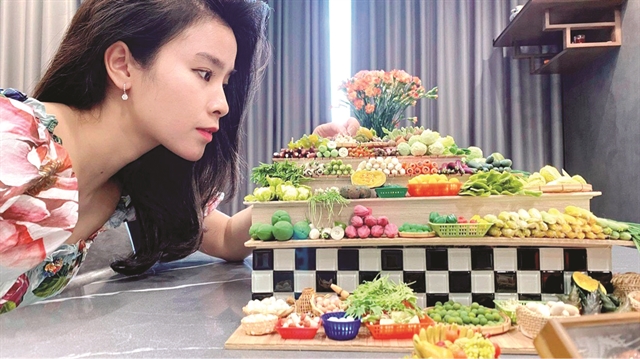
|
| Nguyễn Như Quỳnh and her miniature fruit and vegetable shop. Photo courtesy of Nguyễn Như Quỳnh |
Thanh Hà
HÀ NỘI — Nguyễn Như Quỳnh is making the final touches to her work. She has just completed a dream miniature-bakery that she has planned for a decade.
In her 'shop,' there are many different kinds of cakes, gateaux, bread, cookies and pies – mostly made of clay.
"Everything here is fat-free, which can help people lose weight quickly because they can watch them only," Quỳnh told Việt Nam News of her bakery, which is sized 55x25x30cm.
In the tiny area, visitors can quickly find their beloved colourful macaroons in the right cabinet, donuts with chocolate in the left, and beautiful pastries in the centre.
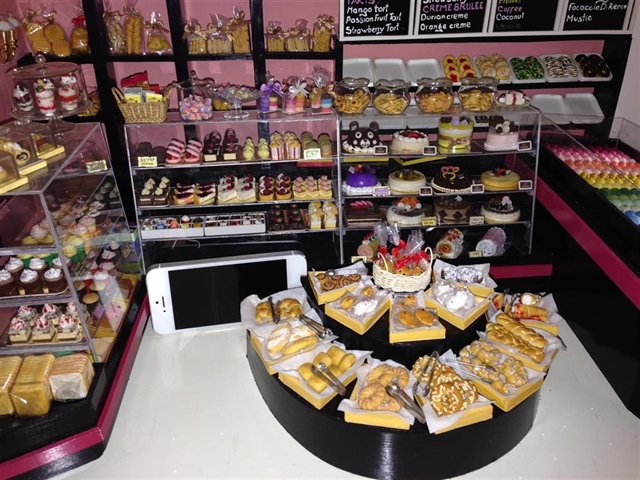
|
| Nguyễn Như Quỳnh has just opened her tiny bakery, with hundreds of cakes made of clay. Photo courtesy of Nguyễn Như Quỳnh |
Many cannot not hide their surprise but admit the cakes look 100 per cent real and mouthwatering to boot.
"Miniature cakes were my first products when I began with this movement 10 years ago. But they were not really nice, so I have practised a lot to finally produce a beautiful bakery that satisfies my wishes," said Quỳnh.
The COVID-19 pandemic has left many people struggling, but it has given the 33-year-old time to complete her Lilliputian creations.
She has spent three months preparing materials, sculpting the clay, mixing colours, and reviewing everything to make sure the tiny cakes are accurate in every single detail.
Earlier in May, Quỳnh made headlines in local media with her shop of vegetables and fruits that she posted on a Facebook group with more than 2 million members. Her post received more than 100,000 likes, 10,000 shares and 1,800 comments.
The Hanoian showed hundreds of items such as papaya, asparagus, bananas, cabbages, chillies and onions, which were only about 0.2-2.5cm long.
"To make such products, I spent a lot of time searching for information and watching YouTube for guidance. I have also observed every object carefully to find out its special details, while I sculpt little by little to make sure every detail is accurate," Quỳnh said.
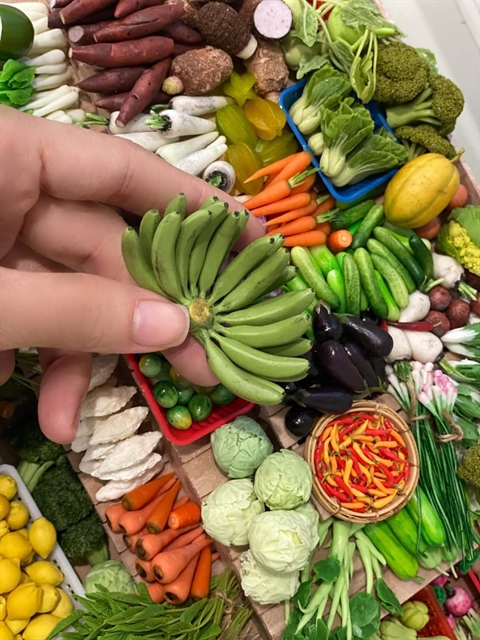
|
| Nguyễn Như Quỳnh has more time for her hobby during the pandemic. Photo courtesy of Nguyễn Như Quỳnh |
Quỳnh owns more than 1,000 tiny products of different themes including food and desserts, drinks and doll house kits.
The mother of one hopes that she will have the chance to organise workshops and meet between interested people to popularise the clay miniature movement in Việt Nam.
Like Quỳnh, Nguyễn Phúc Hậu and Trần Minh Tân have had plenty of time during social distancing to discover new things.
Hậu left HCM City to return to his home town in Bến Tre Province in May because of the spreading pandemic.
The 24-year-old believes that his fish tank is better now that it has been decorated with mini-houses.
"I made a list of everything needed for my construction and draft for the design. Then, I tried to find materials that would be most similar to the real house," said Thuận.
"I use clay to make part of the house and other materials such as carton, bamboo and pieces of wooden board for the rest."
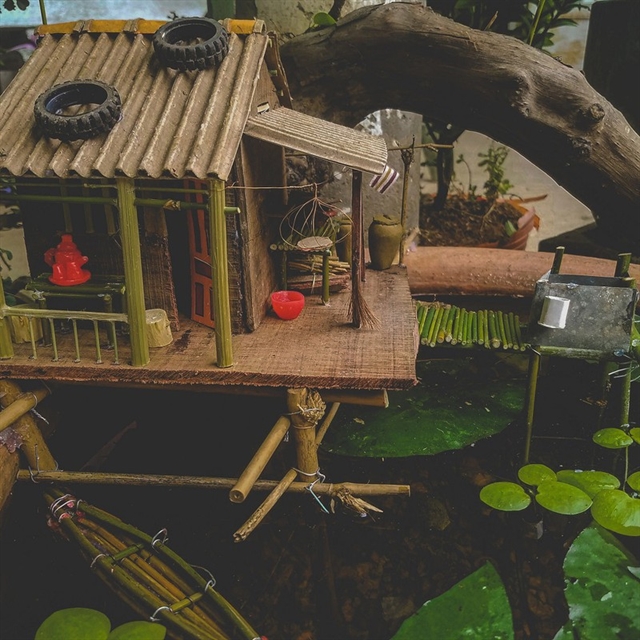
|
| Nguyễn Phúc Hậu's tiny house use familiar materials from around his neighbourhood. Photo coutersy of Nguyễn Phúc Hậu |
After five days, the 10x15cm stilt house was completed fully, with furniture. He also attached tiny household and decorative items.
"It is made of simple materials, which I can find around me. I only use a knife and handsaw to cut, and special glue for metal to stick things together," he said.
Tân, from Biên Hòa City, found his new hobby by accident when he read a website and saw construction replicas made of pieces of lumber and milled wood.
Graduating from Đồng Nai College of Decorative Arts, Tân spent two months searching for more information and collecting materials which were “available and cheap,” and then made his first products.
After six months, he has converted wasted wood, nutshells and toothpick into hundreds of construction models that he has seen during his tours of many cities and provinces.
"Handmade products look easy but they are actually not. With the same material and labour, things are different if you don't have a creative mind, good imagination and talent," said Tân who has been creating handmade items since he was in high school.
"Wooden pieces have their own shapes, colours, texture and wood grain. I am really interested in working with them. Designing a model is not difficult but arranging pieces to match with each other, mixing colours and adding detail requires great skill," he said.

|
| One of Trần Minh Tân's houses made from waste wood collected from workshops and factories. Photo dantri.vn |
"I think that working on a handmade house model is a kind of art, which converts raw and tough wooden pieces into real and lively constructions. I am really pleased and feel relaxed watching my works step-by-step take shape and become complete.”
Recycling wasted items to either make life more beautiful or save the environment is also an idea of 61-year-old Nguyễn Minh Trực from Kiên Giang Province.
Trực saw his wife throwing away plastic cans of oil and detergent and water bottles, and started collected them to make fine-art works during social distancing.
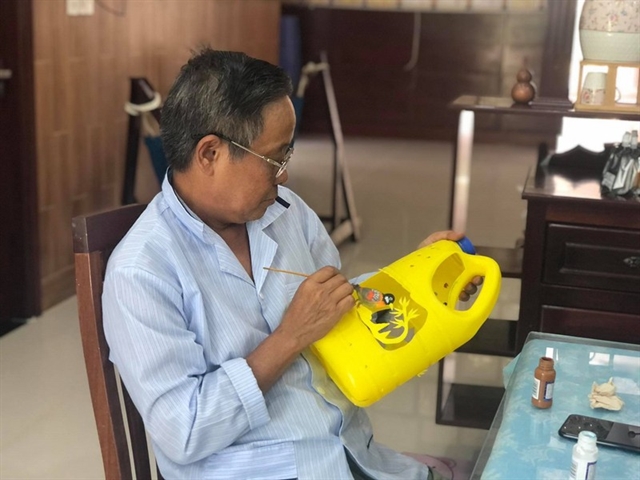
|
| Nguyễn Minh Trực cuts and paints a container to make a fine-art work. Photo courtesy of Nguyễn Minh Trực |
"He can't go out because of the social distancing, so he cuts the cans and draws the 12 animals of the zodiac, and then marine animals too," said Nguyễn Ngọc Trân, Trực's daughter.
The cans are cleaned before Trực makes drafts of his sketches on both sides. He then uses scissors to cut his designs and then colours them. It often takes him up to five hours to complete one product.
His neighbours and friends appreciate Trực's work and send him all the cans they have. Meanwhile scrap shops give him free materials.
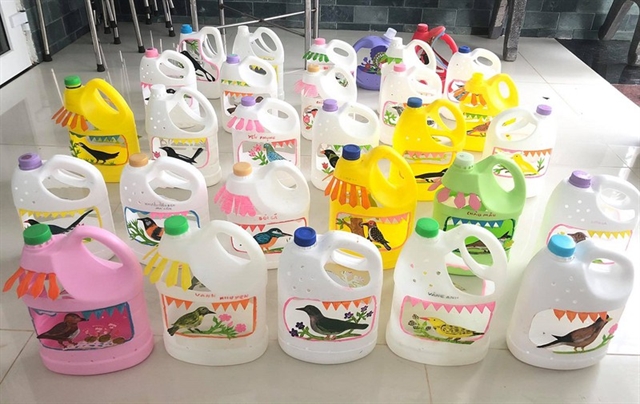
|
| Nguyễn Minh Trực's free time in social distancing is used to make endless decorative cans. Photo of Nguyễn Minh Trực |
"It is great that he has these artistic activities during this hard time. He is strongly supported and encouraged for what he is doing. He is happy because he can partly save the environment and stay safe from the outbreak," said Trân. VNS




